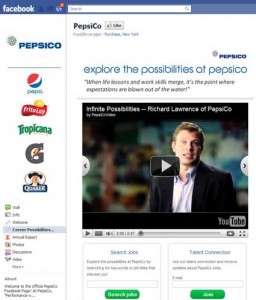
- Tuesday, July 15, 2025
- Stay Connected
Widgetized Section
Go to Admin » Appearance » Widgets » and move Gabfire Widget: Social into that MastheadOverlay zone
How To Use Social Media To Find Your Next Job
Creating visibility for your personal brand
 There was a time in the not too distant past, when looking for a job followed a basic four-step formula:
There was a time in the not too distant past, when looking for a job followed a basic four-step formula:
- Write a resume.
- Check the job boards for a position that fits your experience and qualifications.
- Write lots of cover letters; email or fax them along with your resume to the company you wanted to work for.
- Wait for a phone call, or a letter from a hiring manager with some positive news.
I’m here to tell you that those days are gone forever.
Most people know that the best way to find a job is through networking and there are a lot of great books on how to network. You can go to networking meetings, tap into your own professional network (my personal favorite) or ask friends who they know. But there are many ways to use social media in order to network, and eventually find a job. Here’s how to use social media to find your next job.
Ok, when it comes to the places to look for a job Facebook probably isn’t at the top of your list if it’s even on your list at all. But it should be. Facebook is the largest social network in the world, but it’s not just for sharing pictures or posting status updates. It’s a great tool to help you find a job. Here are two ways you can tap the power of Facebook in your job search.
Use Facebook as a search engine
Pick a company. Any company. Chances are that if you type their name into the search box on Facebook they will have a “fan” page that contains, among other things, information on who they are, cute photos of their employees or their products, a current promotion or two and a list of job openings. Look at the screen shot below of PepsiCo’s Facebook page:

And it’s not just the big multi-nationals. Even smaller companies (like the one I work for) are using Facebook as a way of recruiting talent. Why? Most companies have come to realize that Facebook is a great place to look for employees who understand the power of social media. And that’s something a lot of companies are looking for.
Use Facebook as a virtual billboard
Facebook Social Ads allow businesses and individuals to advertise using Facebook’s news feed or right rail. This program is similar to Google’s AdWords but you can use a picture and its more “word-of-mouth friendly” because the ads travel through the news feeds of friends.
The main takeaway here is to be brief. You’ve got a few seconds to catch someone’s attention, so it’s important to be concise when you say what you’re looking for.
Once you’ve created your ad, link it to your Facebook page, your LinkedIn profile or your blog/website. These ads are all about targeting a specific group that would care about your resume or hiring you so when you select your target audience, keep in mind the company and location(s) you’re looking for.
Twitter isn’t just for gossip or breaking news. It’s a great way to find a job. Once you’ve done your basic research and picked out who you want to work for, set up a search using the hashtag symbol and the company’s Twitter account (#techmedianetwork) and monitor their Tweets. You can also do a search on specific jobs (#accountingjobs).
Just remember, before you respond to any tweets about jobs, or follow anyone on Twitter, you MUST have a completed profile. Make sure your profile has a short bio, your location and a link to a site that recruiters can go to for more information (e.g. your blog or LinkedIn profile).
My friends at Mashable have a great post on how to find a job using Twitter that includes tips on maximizing your page, as well as various search tools and resources to assist with your search.
Linked In
There’s a reason LinkedIn recently went public with a ridiculous valuation. With more than 44 million members in over 200 countries around the world, recruiters are starting to use LinkedIn as the main place for sourcing candidates because it’s free (for now), and the top professionals are listed there.
If you don’t already have one, create a LinkedIn profile, import your address book (it’s fairly easy), and start taking advantage of this tool. You definitely want to complete your entire profile, just like you would a resume, but include the same bio/profile you are using on Twitter (see above) and ensure that the summary section is complete. And while this may seem obvious, make sure your bio information is consistent. The last thing you want is for a recruiter or HR professional to find inaccuracies in your employment record or your qualifications. And trust me, they WILL find them.
If you can, try to get at least one recommendation from a supervisor or friend. That will give you a ‘1? next to a ‘thumbs up’ graphic when people search for you. It helps. Many companies have a policy that prohibits the HR department from saying anything more than, ‘Yes, he (or she) worked her from ‘x’ date to ‘y’ date and their job was ‘blank’. Recommendations on LinkedIn from former coworkers are a great way to provide future employers with an insight into the person they might be hiring.
Blogs
Blogging allows you to showcase your talents to potential employers ‘ they can see how you write, see what’s important to you, see who you are personally and even see examples of your work. Blogs help make you a real person versus a resume.
Don’t just focus on your own blog. Unless you’re Gwyneth Paltrow or Perez Hilton, it’s unlikely you’ll be getting a significant amount of traffic. Consider posting comments on other blogs ‘ this gets your name out there even more, and if you write something interesting, it may catch the eye of a potential employer. Social media guru Chris Brogan suggests blogging on the types of jobs you want. For example, if I want a job at a specific company doing public relations, blog about ideas you have for them. (Oh, and don’t forget to Tweet your blog postings.)
YouTube
YouTube? Seriously? Isn’t that a forum for stupid pet tricks? Or videos of too cute two year olds doing Michael Jackson imitations? No, it’s not.
A search for ‘video resume’ on YouTube will give you close to 2,000 results. Many video resumes are good (while others are so amateur and rehearsed that they subtract from a given candidate’s marketing program). Bottom line: The key with a video resume is that very few people have actually created one, so they serve as a differentiator in the recruiting process.
A good video resume is short, describes the value you can contribute in a given position, explains why you’re the best person for the job and talks about your background in a story-like format. If you weren’t born with an outgoing, lively personality practice a few times before recording your video. Since you’re filming yourself, you don’t need to rush. You can try it a hundred times and ask someone who will give you an honest opinion to critique your video before you upload the final version to YouTube.
In today’s world, social media is an important part of any company’s Marketing and Branding tool kit. It should be part of yours too. Using social media as a tool in your job search not only gives you a leg up on the competition ‘ it also shows prospective employers that you understand how to leverage the power of the medium to create visibility for yourself and for them.







You must be logged in to post a comment Login